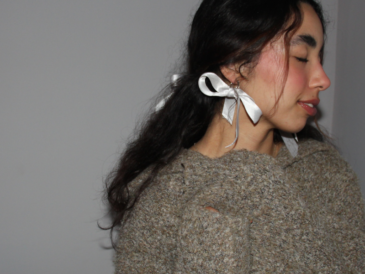Photo taken from Pexels
As “slim-thick” bodies become less prominent in celebrity culture, some say that skinniness is in Vogue again, but was thin ever not in?
With posts featuring Kate Moss, Diet Coke and cigarettes overtaking many young women’s social media feeds, it appears that 90s thinness, controversially referred to as “heroin chic,” is back in style.
This body type emphasizes dark eye circles, pale skin and sickly thin bodies. It was a counterculture movement in the 1990s that was constantly criticized, even by former President Bill Clinton, for promoting drug abuse and malnourishment.
The ultra-thin body type carried on as the standard into the early 2000s, but began to decline in popularity in the 2010s when the body positivity movement began to gain more traction.
According to Brianna Richards, a 22-year-old college student, the body positivity movement has had a huge impact.
“It brought more awareness to the subject and created pathways to further study how media can affect the way we view ourselves physically,” Richards said.
Recently, however, the tides have turned. Kim Kardashian notoriously lost 15 pounds in three weeks for the MET Gala, celebrities are using the diabetic drug Ozempic to shed weight quickly, and young stars, like Lily-Rose Depp, have even repopularized cigarette usage.
So, some say that thin is back in, but did it ever really leave?
In the 20th and 21st centuries, beauty standards for women have shifted every decade or so. Some of these shifts are gradual whereas others are more drastic.
1910s: Corsets were a staple in women’s fashion in order to emphasize small waists and large busts.
1920s: In the flapper era, slender, androgynous figures began to grow in popularity as women slowly began to gain more independence and autonomy. This was also when fitness became a larger priority since bodily insecurities could no longer be hidden under corsets and lengthy dresses.
1930s: This era introduced a subtle hourglass figure with a slim waist, prominent bust and slender legs. Calorie counting grew in popularity during the war since it was deemed “selfish” to eat more than your allotted caloric intake.
1940s: Following WWII, women reverted back to a more slender figure, although this type was more athletic and toned than that of the 1920s. Broad shoulders were also accentuated. Weight loss drugs grew in popularity during this time.
1950s: Curves were the craze of the 1950s following the popularity of sex symbols like Marilyn Monroe and Jayne Mansfield. Weight gain supplements were popularized and “stick” figures were deemed unattractive.
1960s: Twiggy was one of the most influential fashion icons of the era and pioneered the return to extremely thin, androgynous bodies.
1970s: Slender, athletic bodies overtook the 1970s as women became more empowered. Flat stomachs and slim hips were emphasized.
1980s: The 1980s fitness craze highlighted women’s muscles, which was something previously viewed as overly masculine and unattractive. Workouts like aerobics and running grew in popularity as women worked to achieve a toned physique.
1990s: As a countermovement to the fitness craze of the 1980s, the aforementioned heroin chic body type was brought onto the scene as a more “real” and gritty alternative. Thin, waifish bodies were praised in the fashion world, which led to a spike in liposuction procedures.
2000s: Straight bodies with visible abs began to dominate tabloid covers as low-rise bottoms and crop tops gained popularity. During the height of tabloid consumption, celebrity bodies were often compared and criticized.
2010s: Social media brought on a new era of beauty standards for women, which are arguably harder to achieve than the previous ones. Photoshop and Facetune make it impossible to tell what is real or not on posts, which sets impossible standards for young women. “Slim-thick” hourglass bodies were the new craze, and plastic surgery, specifically the Brazilian Butt Lift, became more normalized in order to achieve this look.
2020s: Even though it is only 2023, the shift in the ideal body type is already evident. Instead of influencers promoting lifting heavy and protein shakes, they are now posting about their pilates classes and “wellness shots.” Low rise jeans are back. The notorious Victoria’s Secret Fashion Show has returned.
Gen Z’s preoccupation with early 2000s culture has not only reintroduced some questionable fashion trends, but has now reintroduced the questionable body-shaming trends of the time.
Addyson Beams, a 19-year-old Knoxville native, discusses the effects of social media.
“You get on TikTok and see 5 different girls, some of them posing a certain way making their body seem better, or you see them promoting unhealthy diet plans and starving themselves. On Instagram, you’ll see so many fake bodies, but they’ll all say it’s real. All of it can definitely take a toll on someone’s mind and body,” Beams said.
Despite appearances, the body positivity movement was not as effective as most people like to believe. The slim-thick body was still slim and is no more attainable than an ultra-thin physique. Celebrities are still harassed for weight gain, and thinness is still glamorized in the media.
This is not back in. It never left to begin with.





